I use chart patterns in my trading because they give me tips on how a stock will perform. Sometimes the tip turns out to be a lie, but that's okay. I use stops to limit losses (don't you?). When the tips are accurate, I clean up. This article discusses two such tips: partial declines and partial rises. They forecast the breakout direction from a chart pattern.
When I wrote this in January 2003, we were still in a bear market, and so I concentrated on partial declines -- they predict upward breakouts. What does a partial decline look like? Consider Figure 1, a chart of a broadening bottom. That's my term for what's usually called a broadening top, but I found performance differences between tops and bottoms. For the latest statistical information, consult my book, Encyclopedia of Chart Patterns, Second Edition.
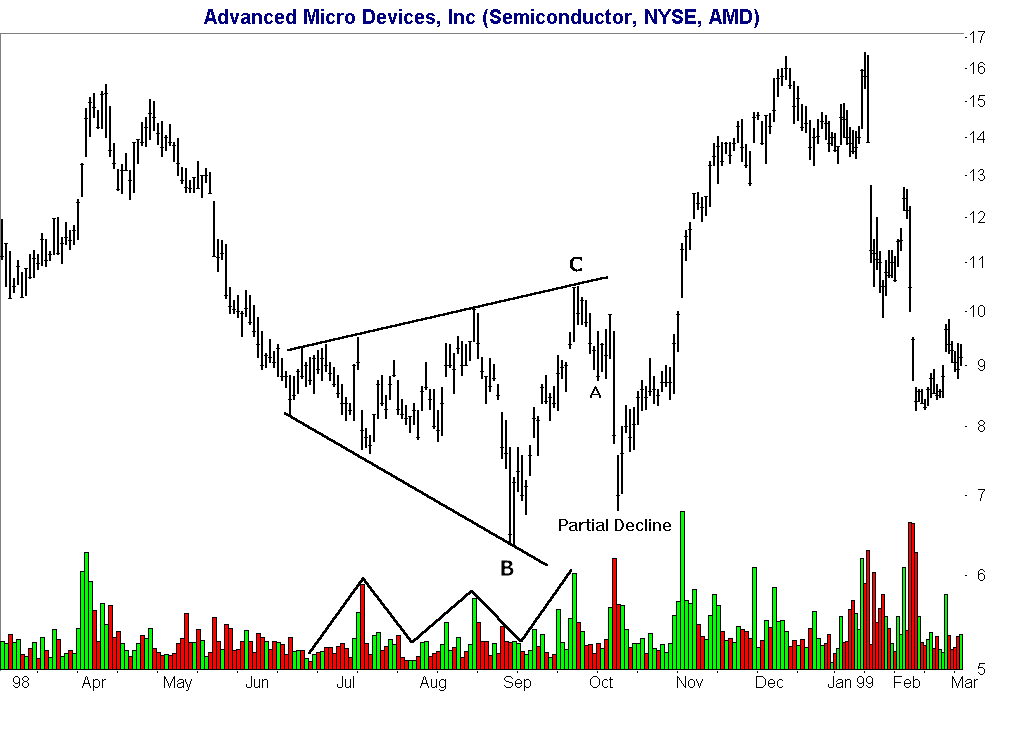
caption: Figure 1: Broadening bottom. A partial decline sees prices tumble but they do not come close to the lower trendline. Point A is a small partial decline that doesn't work out.
Partial Declines: Broadening Bottoms
In a broadening bottom, prices enter the pattern from the top (that is, after a downward price trend), but they can exit in either direction. The pattern sports two trendlines that broaden out over time, one trendline slopes up and the other slopes down. The trendlines should touch at least two minor peaks on the top and two minor valleys on the bottom with little white space in between (good side-to-side price crossings). Volume appears irregular, but usually climbs as prices rise and recedes as prices fall, like that shown.
Once you have a valid pattern (at least two touches of each trendline), then look for a partial decline like that shown. A partial decline is just as it sounds: Prices drop but do not touch or come near the bottom trendline. A partial decline suggests an upward breakout on the next price crossing.
The time to buy is when you are sure prices have started rebounding, completing the turn at the bottom of the partial decline. I have not found a guaranteed way to do this, so it's a judgment call. However, Fibonacci retracements can help. If the decline turns at 50% and especially at 62% of the prior up move (B to C), then chances increase that an upward breakout will follow. Use stops to limit an adverse move, say $0.15 below the partial decline low.
Consider point A in the figure. Price retraces about 38% of the prior rise then begins moving up and it looks as if the stock will stage an upward breakout. Instead, prices drop quickly a few days later and form a new minor low, completing the real partial decline.
In a study I did for my book, Trading Classic Chart Patterns, a partial decline correctly predicts an upward breakout in broadening tops 77% (68/88) of the time (using data from mid 1991 to mid 2001). If a partial decline does occur, expect the rise after the breakout to be less than usual (32% rise versus 36% without a partial decline). It's as if a partial decline sucks energy from the upward momentum.
Broadening Wedges, Descending
Figure 2 shows another partial decline, this time in a descending broadening wedge. The chart pattern has the same megaphone appearance as the broadening bottom, only this time the megaphone tilts down. Prices still broaden out and there are at least two minor peak and two minor valley touches of the associated trendline. Volume usually trends upward over time.
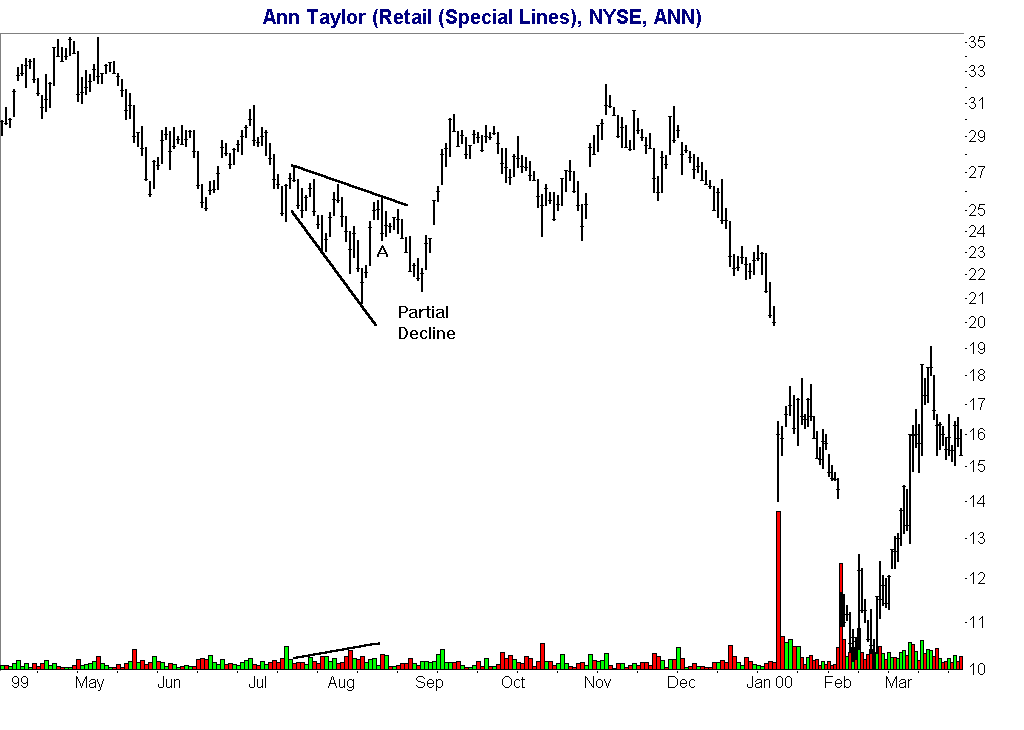
caption: Figure 2: Descending broadening wedge. This megaphone shaped formation tilts down and a partial decline suggests an immediate upward breakout. Point A is a partial decline that doesn't result in a breakout.
Partial declines correctly predict an upward breakout from descending broadening wedges 76% (35/46) of the time.
To prevent investing in what appears to be a valid partial decline (point A), consider a rule like "at the widest point in the chart pattern, prices must travel at least halfway across the pattern before turning around. Such a rule would prevent you from investing at point A in both Figures 1 and 2. Again, the rule uses a Fibonacci retrace of 50% or 68% (for safety).
Rectangles
Figure 3 shows a partial decline in a rectangle top. I call this a rectangle top because prices trend upward leading to the pattern. The breakout can be in any direction, including horizontal, but usually follows the price trend leading to the pattern (up, in this case). As such, rectangles usually act as consolidations of the prevailing price trend, not reversals. Volume typically recedes until the breakout.
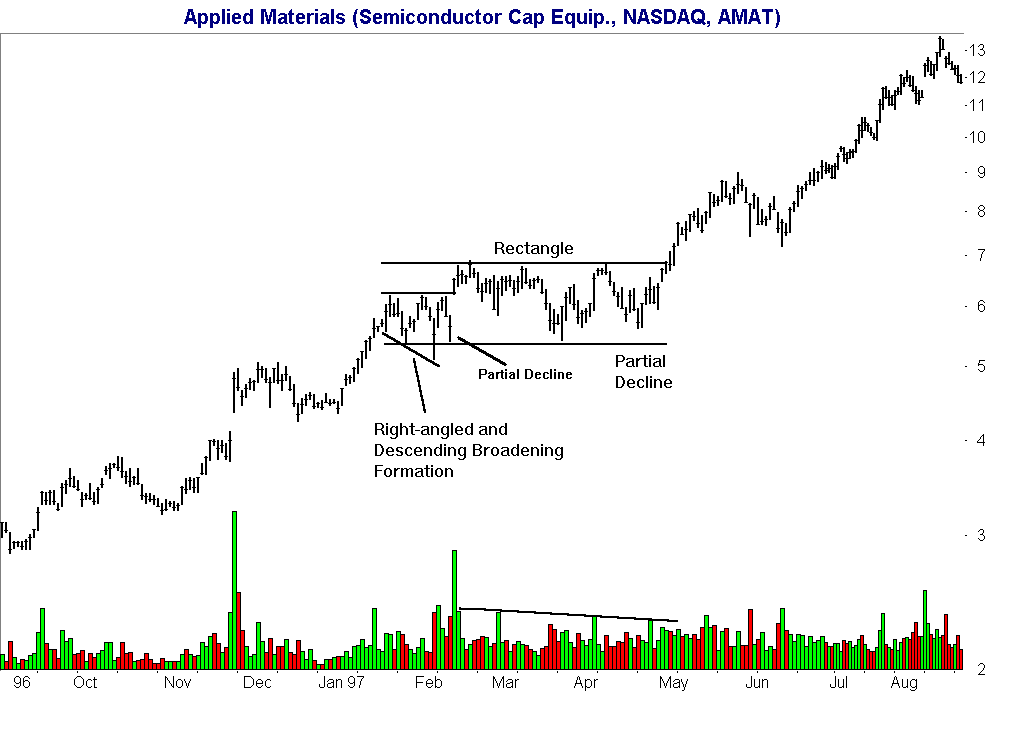
caption: Figure 3: Rectangles. A partial decline in this rectangle correctly predicts the upward breakout direction.
Admittedly, this rectangle isn't perfect, but they rarely are. There are at least two minor peak touches of the top trendline and two minor valley touches on the bottom trendline, as you would expect. Prices drop down out of the pattern early on, forming three touches of the lower trendline of a small right-angled, descending broadening pattern. It also shows a partial decline (the day before price closes above the top trendline).
How often do partial declines predict an upward breakout from rectangles? They were correct in 80 of 113 patterns I looked at from 1991 to 2001, for a success rate of 71%. Again, performance after the breakout is less (34%) when a partial decline occurs than when it doesn't occur (a 37% rise).
Intra-formation partial declines occur 29% of the time in rectangles. That's a lot. An intra-formation partial decline is a partial decline that does not result in an immediate upward breakout. For example, imagine prices touching the top trendline, dropping (but not falling close to the bottom trendline), recovering, and touching the top trendline a second time then zipping across to the bottom trendline. The dip between the two top trendline touches appears like a partial decline, but prices tumble instead of staging an upward breakout.
One way to guard against intra-formation partial rises (PRs) and declines (PDs) is to wait for a valid chart pattern. You must have at least two minor highs touching the top trendline and two minor lows touching the bottom trendline, with prices that fill the structure (that is, not a lot of white space), before you have a valid pattern. Only then should you look for intra-formation PRs and PDs. For reference, broadening tops had intra-formation PDs 9% of the time, and PRs 11% of the time.
Partial Rises: Broadening Formation, Right-Angled and Descending
In the last paragraph, I mentioned partial rises. If you own a stock, wouldn't it be wonderful if you knew when your stock was about to drop? That's what a partial rise does: It warns you of an impending, immediate downward breakout.
Look at Figure 4, a picture of a right-angled, descending, broadening formation. The top trendline is horizontal, the bottom one slopes downward, and both highlight a broadening price pattern. The chart pattern usually acts as a reversal of the price trend, and that's what happens here. The volume pattern typically appears irregular, but recedes in this example.
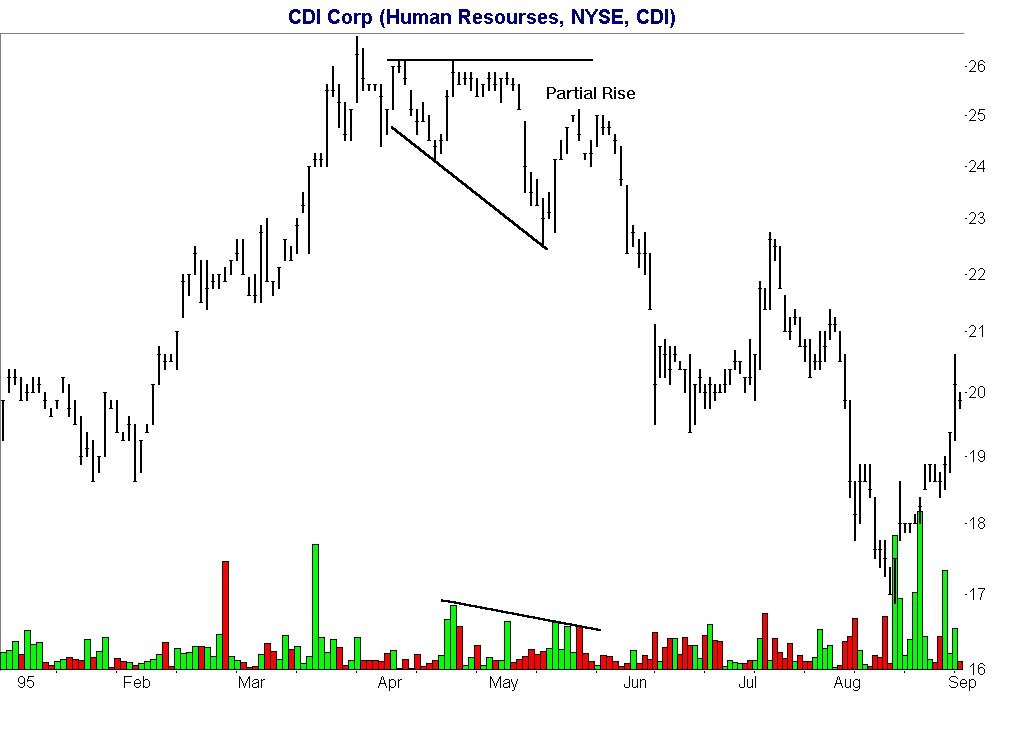
caption: Figure 4: Right-angled, descending broadening pattern. A partial rise occurs after the broadening chart pattern is established. Prices touch the lower trendline, bounce -- but do not come close to the top trendline -- before staging a downward breakout.
A partial rise is similar to a partial decline only flipped upside down. Once you have a valid chart pattern (at least two touches of each trendline), look for prices to climb but not touch, or come close to, the top trendline before plunging. A downward breakout usually occurs immediately (that is, without prices crossing the pattern again, but they may slide along the bottom trendline before pushing through).
Partial rises were correct a paltry 58% of the time (so be cautious) and partial declines were right 78% of the time. These numbers may reflect the bull market data I used from 1991 to 1996. It may be that partial rises correctly predict a downward breakout more often in bear markets.
If you own a stock and prices cross more than halfway up the pattern (say, 68% of the prior move) then round over, consider selling immediately. If you want to short a stock, that's the time to do so.
Partial Rises: Broadening Formation, Right-Angled and Ascending
Figure 5 shows a partial rise in a right-angled, ascending broadening formation. The bottom trendline is horizontal, or nearly so, and the top trendline slopes upward, like that shown. Volume (not shown) has no consistent pattern. Again, look for at least two touches of each trendline before searching for a partial decline or partial rise.
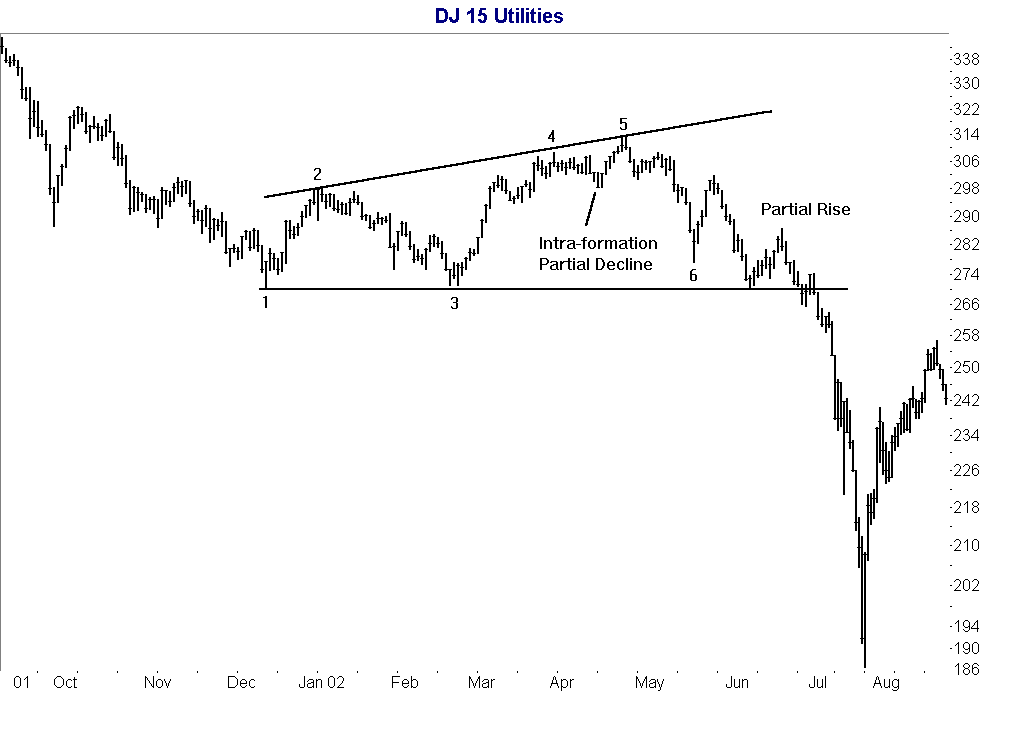
caption: Figure 5: Right-angled, ascending broadening pattern. This is another example of a partial rise in the Dow Jones Utility Average.
This partial rise accurately predicts a downward breakout in the Dow Jones Utility Average. The figure also shows an example of an intra-formation partial decline. The chart pattern becomes valid after two touches of the top trendline and two touches of the bottom one. This appears as points 1 through 4. After the fourth touch (point 4), prices decline then touch the top trendline again at point 5.
If you used half the price difference between points 3 and 4 as the buy signal, you would not have invested in the partial decline (assume this is a stock, not the utility average). Why? Because the partial decline did not dip that far.
However, the minor valley shown as point 6 also appears to be a partial decline that ends badly. Prices tumble from point 5 to more than halfway across the chart pattern, make a good try at breaking out upward, but get sucked down along with the general market in July. Does price come close to the bottom trendline so that it looks like a trendline touch and not a partial decline? I'll let you decide.
The figure highlights a very important lesson. If a chart pattern you invest in doesn't work as expected, exit immediately. Don't keep praying that things will change. They won't. In this figure, if you bought assuming the partial decline at point 6 was valid, the time to sell was when prices closed below point 6, the low of the partial decline (or a point closer to your buy point).
Summary
Partial declines and rises commonly appear in various broadening price patterns and rectangles. For partial declines, prices touch the top trendline, dip (but do not come close to the opposite trendline), then recover and usually stage an upward breakout. Partial rises are similar. Prices touch the bottom trendline, bounce up, and then shoot out the bottom of the pattern -- usually.
Look for partial declines and rises once the pattern is valid. That means waiting for at least two minor peaks touches of the top trendline and two minor valley touches of the bottom trendline before starting your search.
Sometimes, an intra-formation partial decline or rise will occur. That's a partial decline or rise in which prices fail to stage an immediate breakout. Instead, prices zip across the pattern and continue cycling up and down.
For both partial declines and rises and their intra-formation counterparts, consider waiting until prices move at least halfway across the pattern - 68% is best. Anything short of the halfway mark may be a fake partial decline or rise.
If you do buy or short stocks showing a partial decline or rise, close your position if prices move in the adverse direction. Prices may eventually stage a breakout in the original direction, but why risk it? Close out your position and look for a more promising opportunity. Sometimes the best trade you can make is none at all!
Copyright © 2003, 2005 by Thomas N. Bulkowski. All rights reserved.
When I wrote this in January 2003, we were still in a bear market, and so I concentrated on partial declines -- they predict upward breakouts. What does a partial decline look like? Consider Figure 1, a chart of a broadening bottom. That's my term for what's usually called a broadening top, but I found performance differences between tops and bottoms. For the latest statistical information, consult my book, Encyclopedia of Chart Patterns, Second Edition.

caption: Figure 1: Broadening bottom. A partial decline sees prices tumble but they do not come close to the lower trendline. Point A is a small partial decline that doesn't work out.
Partial Declines: Broadening Bottoms
In a broadening bottom, prices enter the pattern from the top (that is, after a downward price trend), but they can exit in either direction. The pattern sports two trendlines that broaden out over time, one trendline slopes up and the other slopes down. The trendlines should touch at least two minor peaks on the top and two minor valleys on the bottom with little white space in between (good side-to-side price crossings). Volume appears irregular, but usually climbs as prices rise and recedes as prices fall, like that shown.
Once you have a valid pattern (at least two touches of each trendline), then look for a partial decline like that shown. A partial decline is just as it sounds: Prices drop but do not touch or come near the bottom trendline. A partial decline suggests an upward breakout on the next price crossing.
The time to buy is when you are sure prices have started rebounding, completing the turn at the bottom of the partial decline. I have not found a guaranteed way to do this, so it's a judgment call. However, Fibonacci retracements can help. If the decline turns at 50% and especially at 62% of the prior up move (B to C), then chances increase that an upward breakout will follow. Use stops to limit an adverse move, say $0.15 below the partial decline low.
Consider point A in the figure. Price retraces about 38% of the prior rise then begins moving up and it looks as if the stock will stage an upward breakout. Instead, prices drop quickly a few days later and form a new minor low, completing the real partial decline.
In a study I did for my book, Trading Classic Chart Patterns, a partial decline correctly predicts an upward breakout in broadening tops 77% (68/88) of the time (using data from mid 1991 to mid 2001). If a partial decline does occur, expect the rise after the breakout to be less than usual (32% rise versus 36% without a partial decline). It's as if a partial decline sucks energy from the upward momentum.
Broadening Wedges, Descending
Figure 2 shows another partial decline, this time in a descending broadening wedge. The chart pattern has the same megaphone appearance as the broadening bottom, only this time the megaphone tilts down. Prices still broaden out and there are at least two minor peak and two minor valley touches of the associated trendline. Volume usually trends upward over time.

caption: Figure 2: Descending broadening wedge. This megaphone shaped formation tilts down and a partial decline suggests an immediate upward breakout. Point A is a partial decline that doesn't result in a breakout.
Partial declines correctly predict an upward breakout from descending broadening wedges 76% (35/46) of the time.
To prevent investing in what appears to be a valid partial decline (point A), consider a rule like "at the widest point in the chart pattern, prices must travel at least halfway across the pattern before turning around. Such a rule would prevent you from investing at point A in both Figures 1 and 2. Again, the rule uses a Fibonacci retrace of 50% or 68% (for safety).
Rectangles
Figure 3 shows a partial decline in a rectangle top. I call this a rectangle top because prices trend upward leading to the pattern. The breakout can be in any direction, including horizontal, but usually follows the price trend leading to the pattern (up, in this case). As such, rectangles usually act as consolidations of the prevailing price trend, not reversals. Volume typically recedes until the breakout.

caption: Figure 3: Rectangles. A partial decline in this rectangle correctly predicts the upward breakout direction.
Admittedly, this rectangle isn't perfect, but they rarely are. There are at least two minor peak touches of the top trendline and two minor valley touches on the bottom trendline, as you would expect. Prices drop down out of the pattern early on, forming three touches of the lower trendline of a small right-angled, descending broadening pattern. It also shows a partial decline (the day before price closes above the top trendline).
How often do partial declines predict an upward breakout from rectangles? They were correct in 80 of 113 patterns I looked at from 1991 to 2001, for a success rate of 71%. Again, performance after the breakout is less (34%) when a partial decline occurs than when it doesn't occur (a 37% rise).
Intra-formation partial declines occur 29% of the time in rectangles. That's a lot. An intra-formation partial decline is a partial decline that does not result in an immediate upward breakout. For example, imagine prices touching the top trendline, dropping (but not falling close to the bottom trendline), recovering, and touching the top trendline a second time then zipping across to the bottom trendline. The dip between the two top trendline touches appears like a partial decline, but prices tumble instead of staging an upward breakout.
One way to guard against intra-formation partial rises (PRs) and declines (PDs) is to wait for a valid chart pattern. You must have at least two minor highs touching the top trendline and two minor lows touching the bottom trendline, with prices that fill the structure (that is, not a lot of white space), before you have a valid pattern. Only then should you look for intra-formation PRs and PDs. For reference, broadening tops had intra-formation PDs 9% of the time, and PRs 11% of the time.
Partial Rises: Broadening Formation, Right-Angled and Descending
In the last paragraph, I mentioned partial rises. If you own a stock, wouldn't it be wonderful if you knew when your stock was about to drop? That's what a partial rise does: It warns you of an impending, immediate downward breakout.
Look at Figure 4, a picture of a right-angled, descending, broadening formation. The top trendline is horizontal, the bottom one slopes downward, and both highlight a broadening price pattern. The chart pattern usually acts as a reversal of the price trend, and that's what happens here. The volume pattern typically appears irregular, but recedes in this example.

caption: Figure 4: Right-angled, descending broadening pattern. A partial rise occurs after the broadening chart pattern is established. Prices touch the lower trendline, bounce -- but do not come close to the top trendline -- before staging a downward breakout.
A partial rise is similar to a partial decline only flipped upside down. Once you have a valid chart pattern (at least two touches of each trendline), look for prices to climb but not touch, or come close to, the top trendline before plunging. A downward breakout usually occurs immediately (that is, without prices crossing the pattern again, but they may slide along the bottom trendline before pushing through).
Partial rises were correct a paltry 58% of the time (so be cautious) and partial declines were right 78% of the time. These numbers may reflect the bull market data I used from 1991 to 1996. It may be that partial rises correctly predict a downward breakout more often in bear markets.
If you own a stock and prices cross more than halfway up the pattern (say, 68% of the prior move) then round over, consider selling immediately. If you want to short a stock, that's the time to do so.
Partial Rises: Broadening Formation, Right-Angled and Ascending
Figure 5 shows a partial rise in a right-angled, ascending broadening formation. The bottom trendline is horizontal, or nearly so, and the top trendline slopes upward, like that shown. Volume (not shown) has no consistent pattern. Again, look for at least two touches of each trendline before searching for a partial decline or partial rise.

caption: Figure 5: Right-angled, ascending broadening pattern. This is another example of a partial rise in the Dow Jones Utility Average.
This partial rise accurately predicts a downward breakout in the Dow Jones Utility Average. The figure also shows an example of an intra-formation partial decline. The chart pattern becomes valid after two touches of the top trendline and two touches of the bottom one. This appears as points 1 through 4. After the fourth touch (point 4), prices decline then touch the top trendline again at point 5.
If you used half the price difference between points 3 and 4 as the buy signal, you would not have invested in the partial decline (assume this is a stock, not the utility average). Why? Because the partial decline did not dip that far.
However, the minor valley shown as point 6 also appears to be a partial decline that ends badly. Prices tumble from point 5 to more than halfway across the chart pattern, make a good try at breaking out upward, but get sucked down along with the general market in July. Does price come close to the bottom trendline so that it looks like a trendline touch and not a partial decline? I'll let you decide.
The figure highlights a very important lesson. If a chart pattern you invest in doesn't work as expected, exit immediately. Don't keep praying that things will change. They won't. In this figure, if you bought assuming the partial decline at point 6 was valid, the time to sell was when prices closed below point 6, the low of the partial decline (or a point closer to your buy point).
Summary
Partial declines and rises commonly appear in various broadening price patterns and rectangles. For partial declines, prices touch the top trendline, dip (but do not come close to the opposite trendline), then recover and usually stage an upward breakout. Partial rises are similar. Prices touch the bottom trendline, bounce up, and then shoot out the bottom of the pattern -- usually.
Look for partial declines and rises once the pattern is valid. That means waiting for at least two minor peaks touches of the top trendline and two minor valley touches of the bottom trendline before starting your search.
Sometimes, an intra-formation partial decline or rise will occur. That's a partial decline or rise in which prices fail to stage an immediate breakout. Instead, prices zip across the pattern and continue cycling up and down.
For both partial declines and rises and their intra-formation counterparts, consider waiting until prices move at least halfway across the pattern - 68% is best. Anything short of the halfway mark may be a fake partial decline or rise.
If you do buy or short stocks showing a partial decline or rise, close your position if prices move in the adverse direction. Prices may eventually stage a breakout in the original direction, but why risk it? Close out your position and look for a more promising opportunity. Sometimes the best trade you can make is none at all!
Copyright © 2003, 2005 by Thomas N. Bulkowski. All rights reserved.
Last edited by a moderator:
